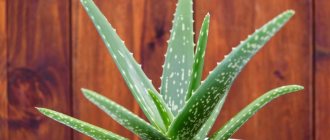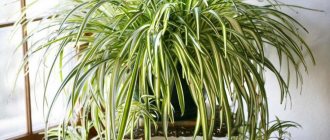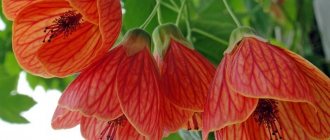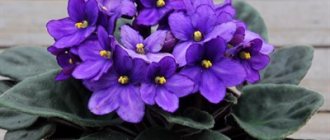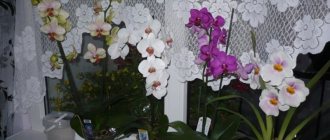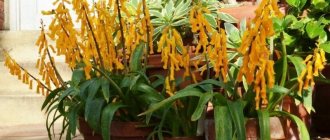In autumn, looking at the fall of leaves outside the window, gardeners often mistake the massive loss of leaves in house plants as a natural process. But is this the norm for all of them?
Leaf fall is an adaptive adaptation in plants that contributes to their survival in difficult natural conditions.
Common pomegranate (Punica granatum)
A very important process of photosynthesis takes place in the leaves, in which light energy is transferred to the plant, and from simple inorganic substances - water and carbon dioxide - the synthesis of complex organic molecules - glucose, amino acids, glycerol, fatty acids - occurs. This is how the leaf “feeds” the plant. For this, in addition to water and carbon dioxide, sunlight of sufficient intensity and a temperature not lower than +5 ... + 10 ° C are required. But, like any living organ, a leaf requires a certain amount of energy and nutrients for its maintenance. If unfavorable conditions arise when the plant is no longer able to fully carry out photosynthesis, it is forced to abandon all or part of its leaves so as not to waste energy and reserves on maintaining organs that are no longer useful to it.
The annual reduction in daylight hours in autumn in the northern latitudes, cooling, and cooling of the soil (which makes it impossible for the roots to absorb water) have developed a mechanism for the plants growing there to shed their leaves annually. For them, autumn leaf fall is a normal, natural and obligatory process; such plants are called deciduous . When growing them at home, it is unacceptable to pick off the still green leaves. You can move it to a dark place only after complete natural fall of the leaves.
Deciduous plants most often grown at home: ficus carica, or fig (Ficus carica), common pomegranate (Punica granatum), Indian lagerstroemia indica, ginkgo biloba (Ginkgo biloba), black mulberry (Morus nigra), Syrian hibiscus (Hibiscus syriacus), palm maple (Acer palmatum).
After dropping the leaves in the fall, be sure to place them in a cool place (+5...+10 oC), maybe in a cellar or basement without light. Without winter rest for several years, plants usually die.
maple (Acer palmatum), bonsai
Semi-deciduous (or semi-evergreen) are plants that resort to shedding leaves not regularly, but only when unfavorable conditions arise, so they have adapted to possible changes in external conditions. Such plants recover quite easily when favorable conditions return.
Non-flowering houseplants
Non-flowering plants are plants that are grown for their beautiful leaves or generally for their attractive appearance. The leaves of such plants can be of different colors and shapes. Typical representatives: ficus, dracaena, succulents.
Small indoor flowers
Ficus
One of the most interesting representatives of non-flowering plants is considered to be indoor ficus. Surely, those who were lucky enough to vacation in any Mediterranean country have seen large glossy leaves on interesting spreading trees. The indoor version of the ficus also looks very elegant. In nature, there are many species of this plant; there are approximately 20 indoor varieties. The most famous is the rubber-bearing ficus , which is rightfully considered a long-liver and, with proper care, can please the inhabitants of the home for about 50 years.
Although ficus trees are relatively easy to grow, they do have some special needs that you'll need to pay attention to. Here are a few things to consider when considering growing a ficus as a houseplant.
- Light. Ficus loves bright, indirect sunlight and lots of it. Your plant will enjoy spending time outside in the summer, but protect the plant from direct sunlight if it is not acclimatized. In winter, keep the plant away from drafts and do not allow it to remain in a room with a temperature below 10-16°C.
- Watering. Ficus needs constant but moderate watering throughout the growing season, with dry periods in winter. Make sure the soil is just moist and not dry or soggy, but reduce watering in winter. Your plant will most likely lose leaves during the winter drought. Hanging ficus trees are especially susceptible to over- and under-watering. Foliar sprays can provide additional moisture during droughts with less threat of root rot. Well-draining soil is essential to keeping these plants healthy.
- Transfer. Ficus grows quickly and can easily become too large for your home if you repot it frequently. Limit potting to once every two years to control your plant's growth.
Ficus rubbery
Ficus benjamina, or weeping fig, is also popular. It's known for dropping its leaves and is generally easy to grow—as long as you don't move it. Ficus prefers to stay put. In fact, the seemingly simple and harmless act of moving it from one corner of the room to another, or even a few meters for that matter, can cause it to lose its leaves.
Flower Investigation: What is the name of a plant with a green stem without leaves?
What are the most unpretentious and beautiful indoor plants in the house?
Dear flower growers! Help me identify the growth factor, I noticed it among my colleagues at work. They don’t know what it’s called; they jokingly called it “skeleton.” It really does look like it: small leaves are occasionally found on the bare green stem. I want to root it, but nothing works. I would look on the Internet to see how to handle it, but the word “skeleton” brings up a lot of things, but it’s all wrong.
M. (Orenburg)
People call two plants “skeleton”: firstly, it is Hatiora salicornioides, also called “dancing bone cactus”, and secondly, Euphorbia tirucalli.
Judging by the photo, you are trying to tame the tirucalli spurge. This comrade is originally from Africa. Today it is found in the Arabian Peninsula and the dry regions of India. In nature, this tree grows up to 10 meters in height. Leaves practically don’t grow on it, and it doesn’t need them. Green stems produce photosynthesis.
Like all spurges, they are poisonous. But monkeys eat its fruits and find them quite tasty. However, in home floriculture, spurge rarely blooms, and even less often it comes to fruit.
Thirukalli has recently been grown as a houseplant, but it is very active. Indeed, the unusual appearance of the succulent adds charm to both a city apartment and an office space. But I would not recommend having him as a pet.
Decorative foliage plants
Decorative foliage plants include plants that have unusually shaped leaves with interesting colors. There are many types of these plants, which differ in appearance and features of caring for them. Selaginella and asparagus , for example, can be recognized by their needle-like dissected greenery.
There are also plants that bloom with small flowers and turn into an original scattering of berries. The most famous representative of this species is the nightshade, which in England is one of the symbols of Christmas.
Reproduction of decorative foliage plants can occur in different ways. For example, Helxina mossy can be rooted by transferring a lump of soil with the plant to a new flower pot. Some types of ficus reproduce using green layering, and tubers are the subject of propagation by caladiums.
Colchicum - flowers are timeless
I met them for the first time as a child in a botanical garden and was very surprised: it was October, windy, cold, rainy, the leaves had long since turned yellow, and here were spring flowers. “These are the experts who made spring flowers bloom in autumn!” - gardener's thoughts...
It turned out that these are not botanists, but nature once again surprises.
These plants are called crocus (Colchicum) because the majority of species and varieties have a very unusual development cycle: leaves appear immediately with seed pods in the spring, seeds ripen in early summer, the leaves turn yellow and die, the plant sleeps in the summer, and flowers without leaves bloom in the fall. .
Colchicums, or colchicums (the name is given from the area where several species of this flower grow), are corms. Their corm is 5-6 cm in diameter, covered with a dry brown shell.
In autumn, a 15-18 centimeter perianth with an elegant flower emerges from the ground, fused into a narrow tube. The flowers appear completely without leaves; for this feature the British call the plant “naked lady”.
Colchicum is an unusual flower not only in terms of its development cycle. He made significant contributions to science. Substances - alkaloids - were isolated from the plant, and during the study of these substances a new branch of organic chemistry was formed.
And in genetic engineering, thanks to the crocus alkaloid colchicine, methods have been developed for obtaining new plant varieties that are larger in size due to the doubled number of chromosomes.
Depending on the species and variety, one colchicum corm can produce a different number of flowers. They can be simple or terry.
And the color varies from white to all shades of lilac-lilac and pink. Checkerboard and striped varieties are also sometimes On cloudy days, the flowers close and stand in beautiful glasses.
Colchicum blooms for about three weeks, depending on the weather: in hot autumn the plant fades faster. He is not afraid of frosts; they can only cause him to lie down on the ground. Pollination occurs with the help of insects; the ovary is located in the corm, at the base of the flower tube.
And the three-lobed seed pods with round seeds at the base of the leaves will be visible only next spring. Therefore, another name for the plant is “son before father.”
In the middle zone they grow well and do not require shelter b. Bornmueller, b. magnificent, b. gigantic, b. autumn and b. dark purple
Fresh colchicum seeds can be sown immediately and seedlings can be obtained in the next season, and after 5 - 7 years - full-fledged flowering plants.
The leaves grow only in spring - oval-elongated, glossy, beautiful bright green, erect, about 30 - 40 cm tall.
In colchicum, simultaneously with the development of leaves, a new, young corm grows, replacing the old one. Sometimes not one, but two or three new corms are formed.
In June, the leaves begin to turn yellow, dry out, and the plant goes dormant until September. At this point, it is recommended to replant the colchicums.
Experienced gardening advice! Plants can be replanted at other times. Somehow I didn’t have time to dig them up in the summer and dug them during flowering (it became not very abundant - a sure sign for the colchicum that it was time to plant it). From one plot measuring 40x40 cm, I dug up half a bucket of corms with numerous thin roots. Some corms were small and had no flower stalks. I planted some of the plants in their original place, having previously replaced the soil there and added compost and sand. The rest were planted in other parts of the garden. In the spring, all the planted plants gave leaves, and in the fall the large bulbs bloomed together. experienced advice from a gardener.
When dug up during the dormant phase, colchicum does not require storing the corms until autumn; they can be immediately planted in the prepared place.
They are buried at three heights of the corm and in a sandy “shirt” (it is advisable to put sand on top and bottom of the bulb).
When planting, you must remember to pay attention to the correct location of the corm: plant with the long tube up, and the beak-shaped outgrowth with the renewal bud (this is the future corm) down. Colchicums are planted in moderately rich soil.
Colchicums appear on sale in garden centers in August - September. On store shelves you can often see sprouted corms without roots, but with flowers.
Don’t be afraid to buy such plants - they are quite viable and, when planted in the garden, will delight you for many years. Moreover, when purchasing flowering corms, misgrading is excluded.
And corms placed in a vase without water can flourish indoors, making a good composition. But it’s better to plant them in the garden right away.
Fresh colchicum seeds can be sown immediately and seedlings can be obtained in the next season, and after 5-7 years - flowering plants
There are a large number of species of colchicum - according to some sources, more than a hundred. Mostly they all bloom in the fall, but there are a few species that bloom in early spring. Colchicum has been known in culture since the 16th century.
In our gardens, varieties and hybrids are most often grown. autumn (Colchicum automnale), b. magnificent (C. speciosum), b. Bornmueller (C. bornmuelleri), b. giant (C. giganteum) and b. dark purple (C. atropurpureum). In the middle zone they grow without problems and do not require shelter for the winter.
Personal experience
The most beautiful variety of colchicum, in our opinion, is the terry variety 'Waterlily' (obtained by crossing the b. magnificent and b. autumn). It really resembles an exotic, bright, deep-double lilac-purple water lily.
However, other varieties also add unusual colors to the autumn garden: consider, for example, the variegated hybrid variety ' Harlekijn ', in which a transverse lilac stripe is visible on the white petals, the large lilac with a white center ' The Giant ', slightly smaller in size ' Lilac Wonder ' or varieties with a dark purple “stem”-perianth: ' Pink Goblet ', ' Nancy Lindsay 1 ' , ' Drake 's Form '. Varieties with white flowers are also varied: there is a double ' Album Plenum ', a small b. autumn ' Album ' and twice as large as b. magnificent ' Album '. The latter has milky white flowers with a greenish tint, like waxy flowers of a perfect goblet shape, which always attract attention. Sometimes double colchicums bloom later than simple ones, and the white double ' Album Plenum ' blooms later than everyone else.
Finding a suitable corner in the garden for colchicums is not easy, since in summer the place where they grow is bare soil, and the yellowing leaves do not add decoration to the flowerbed. You can’t plant them far from the edge of the flower garden - large plants will block these low flowers.
And they don’t like to grow in the shade. So they can be planted in the second row of the mixborder - after the border plants (primroses, heuchera, small hostas). Colchicums also look good under bushes.
Mono planting is also possible - in the spring it will be very bright green foliage; in the summer, in the place where the corms sleep, you can put pots with annual flowering plants - petunia, alyssum, lobelia.
And at the beginning of autumn, as soon as the colchicums begin to sprout, remove the pots and get a gorgeous bloom of numerous bright, large flowers, similar to spring ones.
Expert advice
It is worth noting that colchicums are poisonous plants. Therefore, it will not be superfluous to use gloves when working with them. And like most poisonous plants, colchicum is medicinal.
It has been known as a medicinal plant since ancient times. Its healing properties are mentioned in the annals of Egypt, India, and Greece.
However, due to its strong toxicity, it is dangerous to use drugs containing colchicum on your own without a doctor’s prescription. It is not for nothing that in the Middle Ages recipes for medicines that included this plant were kept secret.
Just in case, you should keep in mind: in case of colchicum poisoning, the patient should be given enveloping agents, milk, tea, and tannin solution.
Source: https://stroyboks.ru/dacha/flowers/bezvremennik-tsvetyi-vne-vremeni.html
Features of climbing indoor plants: photos
Episcia
In appearance, this plant is a curly, low grass with a large number of lateral shoots. They are generally grown as trailing plants because they have unusually beautiful foliage . Caring for the plant is very simple. It loves diffused lighting, so in summer you need to protect it from direct sunlight, and in winter, on the contrary, place it in a well-lit place. You need to water the plant with soft water, carefully avoiding its contact with the leaves.
Soleirolia
This plant is a creeping plant . Its appearance resembles a ball. The stems in this ball are tightly intertwined. The leaves have golden or silver hues. Saltirolia feels great in summer in bright rooms, but direct sunlight should be avoided. But in winter, this plant requires additional light. Soleirolia is unpretentious . In summer, abundant watering is required, and in winter - moderate.
What flower blooms without leaves?
Coltsfoot or Tussilago farfar is one of the earliest flowering perennial plants of the Asteraceae family.
The first flowers appear in early spring, when the snow just begins to melt. The unpretentious plant grows on the banks of reservoirs, slopes of ravines, clay soils, in fields and even on roadsides. Low brown stems appear in thawed areas when spring warmth is not yet felt. The first golden-yellow inflorescences begin to bloom in early April, but there are no green leaves at all. Flowering without leaves is one of the features of this unique plant.
Coltsfoot inflorescences are very sensitive to sunlight. Yellow baskets open in the morning and turn after the sun, and in cloudy, rainy weather and at night the inflorescences are closed. That is why people call them little sunflowers. Cheerful baskets delight the eye, awaken spring in the heart, and the plant is also an early honey plant. Bees collect nectar and pollen from flowers and then process them into honey. In May, flowering ends, and instead of bright flowers, achenes appear that resemble a tuft or parachute. The wind picks them up and carries them far from the mother plant. After this, the flowering shoot dries up, the stem is filled with fresh juices, and after a while green leaves appear.
Summer leaves are completely different from spring inflorescences. The bright green leaves are smooth and cool on top, so they are often compared to a stepmother. The lower part of the leaf is covered with white velvet fibers that retain heat. This side is soft and warm, like a mother's touch. This is where the Russian name for the medicinal plant comes from.
What indoor palm trees look like: photos, names
Indoor palms can come in different sizes and have a wide variety of leaf shapes. They grow rather slowly, so you should not hope that its size will increase very quickly. Indoor palms can be pinnate or fan-leaved.
Date palm
There are about 17 species of date palms. "Finger date" is a houseplant that has a shaggy column-shaped trunk and can grow right up to the ceiling. It is this palm tree that can be grown by planting the seed of an ordinary dried date in a flower pot. However, it is better to take an inedible date for this purpose.
Areca
Areca is an extremely interesting palm tree with a flexible trunk on which a large number of scars can be seen. The crown consists of a bunch of beautiful leaves. Areca can grow up to 2 m indoors.
coconut trees
The coconut palm is not the best representative for growing at home. The exceptions are the nut-bearing coconut, Foster's howea, Belmore's howea, Hamerops squat and Liviston palm.
Euphorbia TIRUKALLI IS DANGEROUS FOR THE HUMAN BODY
Some people mistakenly believe that Euphorbia tirucalli is a folk remedy for cancer. But this is not true at all. Numerous medical studies have shown that the plant is harmful to the human body.
Thus, spurge tirucalli suppresses the immune system, thereby contributing to the development of latent human diseases. Scientists were interested in the fact that in African countries, where this milky plant is used as a medicine, people often suffer from Burkitt's lymphoma. It has been found that the population is often a carrier of the Epstein-Barr herpersvirus, which scientists believe is the cause of the development of Burkitt's lymphoma.
In addition, scientists have discovered that milkweed contains phorbol esters, which are also called “tumor promoters.” This means that in combination with a number of harmful factors (for example, the effects of carcinogens), the risk of malignant tumors increases.
CARE, BREEDING
But if you are convinced that you can follow all the precautions, I inform you that the plant is unpretentious. It's easy to grow
Care is the same as for all succulents: rare watering, air- and water-permeable soil, bright sunlight (but without fanaticism).
Propagated by cuttings. Having broken off a branch, put it in water for several hours so that the milky juice runs off, then dry it well, and now root it in a sand-earth mixture.
At the end of the 20th century in Brazil, the oil industry became interested in the research of Kelvin, who claimed that oil could be extracted from milkweed. He even calculated that from one acre of land on which tirucalli grows, 10-50 barrels of oil can be obtained. But how the matter ended is unknown; no other information about the project could be found.
What are succulents: videos and names
Succulents have excellent decorative properties. With their help you can decorate even a poorly lit interior. Succulents do not require high temperatures to thrive, but humidity levels do need to be high. Therefore, it is advisable to install some kind of fountain or aquarium next to the plant.
Detailed guide - Succulents: types and names with photos
There are many types of succulents. The most famous are aloe, agave, and wild Kalanchoe. But the most popular and famous are, perhaps, cacti. You can learn how to plant succulents by watching the video
Fruit houseplants: photos and names
Avocado
The plant belongs to the Laurel family, genus Perseus. Having a rather unattractive appearance, it has excellent taste and is a very healthy dietary product - it does not contain harmful fats. You can grow it from a seed yourself.
Pomegranate trees
Dwarf species of are used for growing indoors . They grow no more than 1 m in height, bloom for quite a long time and form small but very tasty fruits.
Lemons
Buying lemons is not a problem today. But a small tree growing in an apartment brings joy to all its inhabitants. After all, the lemon smell comes from just one blooming flower. But the appearance of small fruits, painted bright green, delights both the apartment residents and their guests.
Read more: Lemon tree at home: care
Colchicum is an interesting flower that blooms in autumn.
In mid-autumn, all trees and shrubs shed their leaves to prepare for hibernation. After the first frost, fallen leaves lie on the ground mixed with snow. And at this time, light lilac or white flowers emerge from under the snow.
This happens during the first frost! Just some kind of miracle! It turns out to be a beautiful picture, and many will agree with this. Yes, this flower is intriguing, and its name is autumn crocus, known as Colchicum autumnale.
It is the colchicum that blooms in late autumn.
As noted above, colchicum is an amazing flower. The corms of this plant remain in the soil all winter, and in the spring it grows folded leaves that die in July.
Starting in mid-September, the corm takes root and flowers appear, several dozen per plant. The plant can bloom for about a month, and some species even longer.
An interesting fact is that while the crocus is blooming, its seeds do not have time to ripen.
In fact, the birthplace of this flower is the sunny Mediterranean. In summer, all the plants here fight for survival, as drought sets in. Thus, the life of all plants in this region occurs during favorable months of the year, and they survive drought in the form of corms.
How to plant colchicum in the garden plot
This flower will delight many gardening enthusiasts with its unpretentiousness. The flower can grow on any soil, but it will bloom best on loose soil that allows moisture and air to pass through perfectly.
As for lighting, it can be anything - colchicum (colchicum) feels great in the shade and in the sun. The plant also tolerates summer drought well, and frosts are not a hindrance to it, so the bulbs do not need to be removed from the ground for the winter.
But there are a few exceptions, including white and double varieties. They are sensitive to frost, so they should be covered with leaves during the winter.
How to grow colchicum in the garden
Colchicum can be propagated in two ways:
- Seeds . If you want to plant colchicum in your garden plot, then this method will not work. In this case, the colchicum will not bloom for 6 or 7 years, since the corm needs to gain strength to bloom. But if this fact does not matter, then sowing should begin after harvesting in the spring. Seeds should be sown in loose and moist soil.
- Daughter corms. This method is the easiest for propagating colchicum. First, the corms are collected. It is necessary to collect them for propagation in July; it is at this time that the plant’s seeds ripen and the leaves turn yellow and fall to the ground. It should be noted that the bulbs should be dug up carefully, since they are located in the soil at a depth of 30-35 cm. Next, the bulbs should be cleaned of soil and the remains of leaves with old bulbs, while the scales covering the tuber do not need to be removed. Then the bulbs need to be washed in water and seasoned with a weak solution of potassium permanganate, dried in a dry, dark place at room temperature.
Planting or replanting of colchicum should occur no earlier than August. It is this month that is considered the most favorable for plant propagation (during this period, the crocus is at rest).
The planting depth of the plant mainly depends on the size of the corm. Small ones are planted to a depth of 8 cm at a distance of 15 cm, and large ones to a depth of 15 cm at a distance of 25 cm.
When planting, the soil for corms should be the same as when planting seeds - loose and fertile.
When breeding crocus, you also need to take into account that it is advisable to replant it after a few years and at the same time remove old bulbs. If you don’t do this, there will be a lot of them in one bulb. For this reason, the plant will stop blooming.
How to care for Colchicum
As noted, colchicum does not require special care, but there are points worth paying attention to:
- Trimming. There is no need to prune the plant. Many amateur gardeners cut dried flowers in the fall and leaves in the summer to maintain the appearance of the flower garden. It's better not to do this. The fact is that for the corm to ripen, it will need strength, so you should not interfere with the natural process. You can plant plants next to the colchicum that will bloom in summer, so they will cover the dried flower.
- Watering. There is no need to water the colchicum abundantly. This is contraindicated. In this case, the corms rot. The flower should be additionally watered only if the period is dry.
- Feeding. It is better to feed the flower at the time of planting the corms. Next (in spring and summer) you can feed the crocus with nitrogen fertilizers. Thus, it will form strong and large leaves, and the colchicum bulb itself will contain more nutrients. When planting colchicum, you can use tree resin, and then every year you can use nitrogen fertilizer while the stems and leaves of the plant develop.
Colchicum varieties
The Colchicum genus includes up to 100 species of plants growing in the Mediterranean. It is worth noting that only some of them are cultivated.
Autumn colchicum or Colchicumautumnale
This flower grows in warm areas of Europe. Its leaves begin to grow in the spring and die off in the summer. Colchicum blooms in autumn, several flowers (1-4) appear from one corm. The flowers are white and light lilac in color, up to 7 cm in diameter.
Colchicum splendid or Colchicum speciosum
This type of plant reaches a height of 30 cm. Its flowers have a pinkish or mauve color.
Many gardeners successfully cultivate it. Colchicum of this species has several interesting varieties with a checkerboard or striped color. Water Lily is considered the most beautiful in this family.
Colchicum Cilician or Colchicumcilicicum
This species is widespread in Turkey. It reaches a height of 60 cm and at the time of flowering produces up to 25 flowers from one bulb. The flowers have white tubes and lilac-pink petals. The plant begins to bloom in the fall, and leaves grow in the spring.
Colchicum Byzantine or Colchicumbyzantinum
The leaves of this species grow in spring and bloom in summer and autumn. From one bulb grows 12 flowers, 10 cm high, lilac-pink in color.
This type of colchicum is perfect for a summer cottage.
In the end, I would like to note that colchicum is a poisonous plant (all its parts), so you need to wear gloves when working with it, otherwise you can get burns. But if this fact does not frighten you, then you can plant such beauty on your summer cottage.
https://vosledoma.com/bezvremennik-interesnyj-cvetok-rascvetayushhij-osenyu/Colchicum is an interesting flower that blooms in autumn | Near the Househttps://vosledoma.com/wp-content/uploads/2015/02/bezvremennik-1-400×300.jpghttps://vosledoma.com/wp-content/uploads/2015/02/bezvremennik-1-400 ×300-150×150.jpg2019-01-04T20:13:57+03:00Near the HouseFlowers and lawns growing plants, plants, plant care In mid-autumn, all trees and shrubs shed their leaves to prepare for hibernation. After the first frost, fallen leaves lie on the ground mixed with snow. And at this time, light lilac or white flowers emerge from under the snow. This happens during the first frost! Just some kind of miracle! It turns out to be a beautiful picture, and with...Near the House [email protected] Near the House
Source: https://vosledoma.com/bezvremennik-interesnyj-cvetok-rascvetayushhij-osenyu/
